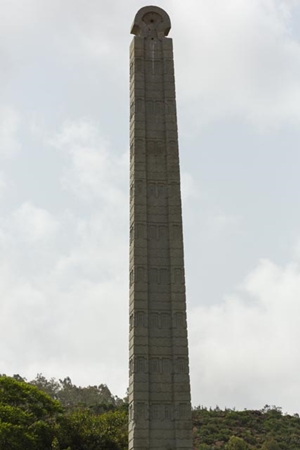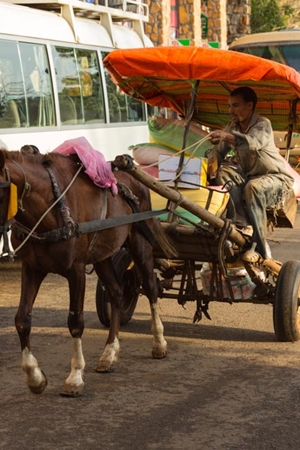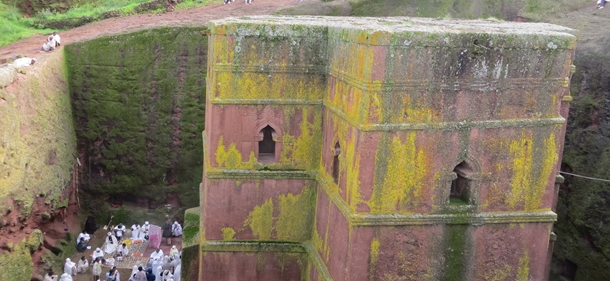 Lily, our Ethiopian specialist, continues her trip around Ethiopia. In this final installment of her diary she visits the northern town of Axum, the mythical home of the Queen of Sheba and the Ark of the Covenant. She then flies onto Lalibela and its amazing churches hewn from the living rock.
Lily, our Ethiopian specialist, continues her trip around Ethiopia. In this final installment of her diary she visits the northern town of Axum, the mythical home of the Queen of Sheba and the Ark of the Covenant. She then flies onto Lalibela and its amazing churches hewn from the living rock.
Sunday 28th July
Up 0615, tasty breakfast then off to the airport for flight to Axum. Melkam collected us at 0815, usual routine of showing passports to armed guards on the airport perimeter before proceeding to terminal. Melkom checked us in and we boarded the flight to Axum, situated well to the north and close to the Eritrean border. Boarded a Q400 Embraer very fast takeoff and landing plus braking hard. Take off 1000, arrived 1050. Met on arrival by our driver and vehicle and off to the Sabean Hotel on the main street – very nice indeed, probably best hotel we stayed in. Modern and well appointed, everything ‘worked’. Tasty food, staff attentive and pleasant, very comfortable rooms.
Early lunch followed by visit to discover the sites of Ethiopia’s earliest capital in the 10th century BC, proclaimed by the Queen of Sheba.
Axum rose to importance around the time of the birth of Christ and was the capital of the far reaching Axumite Kingdom. This Kingdom dominated the vital crossroads between Africa and Asia for almost a thousand years and is the location of its first ecclesiastical building, the Church of St Mary of Zion where according to legend the biblical Ark of the Covenant was placed.
 The Axumites introduced a written language, Ge’ez, and created a new imperial power and political cohesion. They also gave Ethiopia its first organised religion – Christianity – in the 4th century AD.
The Axumites introduced a written language, Ge’ez, and created a new imperial power and political cohesion. They also gave Ethiopia its first organised religion – Christianity – in the 4th century AD.
The spectacular rise of Islam in the 7th century was the main cause of Axum’s decline. However, even after the realm’s decline, the city remained Ethiopia’s religious capital as well as place where several medieval emperors went to be officially crowned. The town abounds in archaeological remains – including graves of kings, the foundations of a palace, inscribed tablets and great carved obelisks.
It is with these famous obelisks or monolithic stelae that Axum is widely identified. In ancient times seven of these obelisks stood together but the biggest measuring 108 feet high and weighing 500 tons fell in some remote period and now lies smashed on the ground to the right of the standing stele. The second largest stele about 79 feet high also fell and was stolen during the Fascist Italian occupation on the personal orders of the dictator Mussolini. Happily this has now been returned and is being erected again, currently supported by scaffolding. Luckily the third largest stele measuring 75 feet high still stands in Axum.
All seven giant stelae are made of single pieces of granite and have identical decoration resembling a tall, slender multi storied house in the architectural style of the Axumite houses and palaces, decorated with representations of doors, windows and door handles.
Amazing to see the Stelae park (which is very justified in being a UNESCO World Heritage Site) followed by the Archaeological Museum just behind the stelae area.
Drove out of town to small obelisk followed by children up the rough track where we abandoned the bus and walked the remainder of the way to the top of the hill and Melkam took us around the ruins of the palace and tomb of King Kaleb and King Gebre Meskel.
Back down hill, boarded coach and after a short distance realised we had a puncture! We were conveniently adjacent to a huge water  reservoir hewn out of solid rock known as the Queen of Sheba’s Bath which is the focal point of the annual ceremony of Timkat (Epiphany) in which each January, a replica of the Ark of the Covenant is carried in procession. While the wheel/tyre was being changed, we became the focus of local attention with children keeping up their bombardment of requests for us to make purchases of artefacts (all original of course!) such as amethyst stone and small icons. Each area we visited seemed to have a special craft of significance which we were pressed with great charm to buy!
reservoir hewn out of solid rock known as the Queen of Sheba’s Bath which is the focal point of the annual ceremony of Timkat (Epiphany) in which each January, a replica of the Ark of the Covenant is carried in procession. While the wheel/tyre was being changed, we became the focus of local attention with children keeping up their bombardment of requests for us to make purchases of artefacts (all original of course!) such as amethyst stone and small icons. Each area we visited seemed to have a special craft of significance which we were pressed with great charm to buy!
Many of the local people just carried on their daily lives around us with donkeys, cattle, goats and sheep being herded past the bus with total indifference; many of the women covered their faces and turned away.
Eventually, all repairs done and we drove back to the hotel for a very welcome lunch. Out again at 1400 and headed for the Park of Stelae which I mentioned earlier followed by the Church of Saint Mary of Zion (100 birr charge to take video footage) and nearby the well-guarded sanctuary chapel of the last resting place of the Ark of the Covenant which we were only allowed to view and not enter. It is claimed that the son of the Queen of Sheba and King Solomon whose son Menelik is said to have brought the Ark to Axum 3,000 years ago where he founded the Solomonic dynasty of which Haile Selassie was the last emperor.
We looked around the excellent museum situated between the Ark chapel and the Church Saint Mary – many artefacts which were priceless but kept in relative primitive state such as silver, armoury, rich robes. Many things piled up in the corner and not displayed at all although we could tell they were quite precious!
Back into town and site inspection of the Yeha Hotel (of the government owned Ghion group of hotels as per Goha Hotel at Gonder). Great view looking over to Queen of Sheba’s Bath, Stelae Park, Church of Saint Mary of Zion – best view of the hotels but dated in decor. For me, that is not a deterrent to recommendation as per the old story… the original hotels were usually built in the best locations for views, access etc. Important to explain to client then it is the client’s choice.
We also looked at the Consular Hotel which has handy location on Main Street but not as well appointed as the Sabean hotel where we were staying. Also visited the Remhai Hotel -slightly run down and in need of renovation.
Very pleasant evening at the hotel.
Monday 29th July
Up 0615, breakfast then at 0815 collected by Melkam, and bus off to airport. Same procedure re passport checks at airport perimeter followed by another check before entering Departure Terminal. Melkam checked us in once again and we boarded our flight to Lalibela, take off at 1050 for the 40 minute flight. Another Q400 Bombardier flight with seating configuration 3-3. Lovely morning.. quite hot in fact. Met by our new driver and vehicle and drove up the valley and ascended up a switch back road over the pass to come out onto a highland area. Up hill and down dale past local architecture of a different style
 Lalibela lies on a natural 2,600 metre rock terrace surrounded on all sides by rugged and forbidding mountains in the northern extreme of the Wollo region.
Lalibela lies on a natural 2,600 metre rock terrace surrounded on all sides by rugged and forbidding mountains in the northern extreme of the Wollo region.
Site visit to Lalibela Lodge. stunning view over to Lalibela and the valley below – only opened 12 months ago. Pleasant chalet style rooms. Recommended for clients. Then on to Mountain View Hotel, architecturally inspired by the rock churches of Lalibela, perched on another hillside with magnificent view overlooking Lalibela Town. Very attractive hotel with good restaurant and Jamaican chef! Pleasant rooms and public areas. Good place for clients to stay.
We had a very tasty lunch here before heading off to the UNESCO World Heritage Site of Lalibela, often called the Eighth Wonder of the World with its 11 medieval monolithic rock hewn churches built in the 12th Century. Formerly known as Roha, Lalibela now bears the name of King Lalibela (1181- 1221), a member of the Zagwe dynasty. When Lalibela was crowned, he gathered masons, carpenters, tools set down on a wage scale, and purchased the land needed for the building. The churches went up with extraordinary speed, goes the legend, because the angels continued the work at night! Some sources estimate that over 40,000 people would have been required to carve the churches
Physically prised from the rock on which they stand, these towering edifices seem superhuman in scale, workmanship and concept. Some lie almost completely hidden in deep trenches while others stand in open quarried caves.
A complex and bewildering labyrinth of tunnels and narrow passageways with offset crypts, grottos and galleries connects them all. Throughout this mysterious and wonderful settlement, priests and deacons go about their timeless business.
To see all the churches takes a long time which we did not have only starting our visit around 1400. We drove to the entrance, Melkam paid the fees and we were assigned a guide whose main job was to look after our shoes which had to be taken off outside when we entered each church. I paid 300 birr (receipt given) for permission to use the JVC camera during the visit – challenged on several occasions by various priests when they saw me filming who asked for sight of the receipt.
We found the whole experience of Lalibela (formerly known as Roha) absolutely awe inspiring and personally I would like to go back one for a re-run! We visited the first group of six churches lies in rock cradles one behind the other north of a stream known locally as the Jordan river. Bet Golgotha, Bet Mika’el, Bet Maryam, Bet Mesket, Bet Danaghel and Bet Medhane Alem.
Bet Medhane Alem is the largest of all the Lalibela churches. It is built like a Greek temple, being entirely surrounded by square columns with a further forest of 28 massive rectangular columns supporting the roof inside. The interconnected churches of Bet Golgotha and Bet Mika’el form the most mysterious complex in Lalibela. Its holiest shrine – the Selassie Chapel – is housed here and according to the whispers of the priests, perhaps even the tomb of King Lalibela himself.
We spent over two hours exploring these churches while the rain started from drizzle to heavy… then walked over to Bet Giorgis, the most magnificent, elegant and remarkable of all the rock hewn churches. This is located in the south west of the village on a sloping rock terrace. By this time, it was pouring down and the rocks were slippy – very important to have footwear with good ankle support and tread for a visit to the Lalibela churches. We walked down a long series of steps into the deep pit with perpendicular walls, it can only be reached through a tunnel entered a distance away through a trench.
Small round caves and chambers have been found in the courtyard walls which were originally graves for pious pilgrims and monks.
Legend says that when King Lalibela had almost completed his churches, he was severely reproached by Ethiopia’s national saint, Saint George, who in full armour rode up to him on his white horse. Saint George said ‘why have you not constructed a house for me’? Lalibela immediately promised the saint the most beautiful church and Saint George personally supervised the work as attested to by the fact that the monks still show the hoof marks of his horse to visitors today!!
Standing on a three tiered plinth, Bet Giorgis is shaped like a Greek cross and has walls – with an alternation of projecting and recessing horizontal layers. It is totally stunning and unforgettable and is the symbol of Lalibela.
We were literally rained off and boarded the Dinknesh bus and headed towards the Roha Hotel (originally part of the Ghion group, government owned). Very comfortable and good location on outskirts of Lalibela town. Spacious public areas, plenty of sitting areas and wifi available. Comfortable rooms and plenty of hot water for bath/shower!
After drying out from the soaking we got viewing the Lalibela churches and waiting until the rain had stopped, Melkom took us on foot up the road about 10 minutes away to the Tukul Village Hotel for a site inspection. Liked this hotel with its attractive rooms – Dutch/Ethiopian venture.
Supper at the Roha Hotel but my chicken was virtually inedible! I wouldn’t normally mention it, but the general feeling was that the food was not as good as in other places. Really liked the hotel with excellent staff, pleasant ambience and views and would send clients there but advise about the food being variable.
Tuesday 30th July
Up 0600, breakfast 0700 and depart 0800 from Roha Lodge back to Bet (Beit) Giorgis church to catch the early morning worship. This was very emotional and spiritual with hundreds of pilgrims and worshippers mainly dressed in white or with white shawls, standing, sitting and praying all facing the
magnificent Bet Giorgis rock hewn church. There was a loud speaker chanting out the prayers which the worshippers seemed to be following in their prayer books. There were also groups of worshippers down at the base of the church and above the sky was blue and the sun was shining on this almost supernatural scene.
 It was a photographers paradise and I got amazing footage trying to capture the essence of this extraordinary scene without being overly intrusive.
It was a photographers paradise and I got amazing footage trying to capture the essence of this extraordinary scene without being overly intrusive.
The Ethiopian people are generally very good natured about having their photographs taken but personally I cannot bring myself to stick a lense in someone’s face so prefer to stand back and get very natural shots of interaction between people without them posing.
From the church we walked over to another area for more exploration involving lots of climbing and underground passage navigation. I felt we were just getting ‘our heads round what Lalibela is all about’ when it was time to leave and rejoin the bus for our journey back to the airport….
The churches in and around Lalibela are a living link with the past and testify to the power and spirit of an ancient Christian faith .. this statement sums up the Lalibela of today. A particularly significant time to visit Lalibela is during the colourful Ethiopian Christmas and Timkat (Epiphany) celebrations on January 7th and January 19th respectively. Please note there is very heavy pressure on accommodation at this time so tell clients to book early.